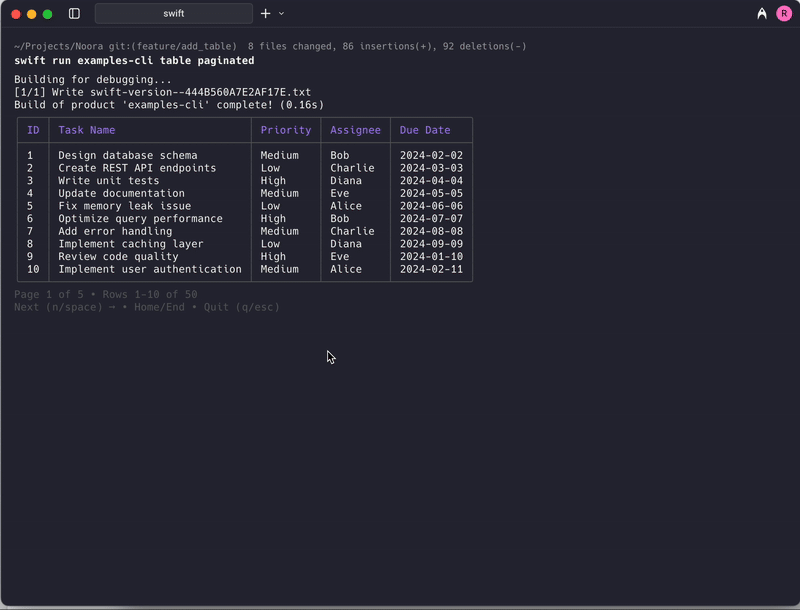Paginated Table
This component displays large datasets in a paginated format, allowing users to navigate through multiple pages of data. It's perfect for displaying extensive lists, logs, or any dataset that would be overwhelming to show all at once. Users can navigate between pages using keyboard controls without selecting individual rows.
| Property | Value |
|---|---|
| Interactivity | Required (fails in non-interactive terminals) |
Demo

API
Basic Example
swift
// Simple paginated table with string arrays
let noora = Noora()
// Large dataset that will be split across multiple pages
let largeDataset = [
["React", "18.2.0", "Active"],
["Vue", "3.3.4", "Active"],
["Angular", "16.1.0", "Deprecated"],
["Svelte", "4.0.5", "Active"],
["Ember", "5.1.0", "Maintenance"],
["Alpine.js", "3.12.0", "Active"],
["Preact", "10.15.1", "Active"],
["Solid", "1.7.8", "Active"],
["Qwik", "1.2.6", "Active"],
["Lit", "2.7.5", "Active"]
]
try noora.paginatedTable(
headers: ["Framework", "Version", "Status"],
rows: largeDataset,
pageSize: 4
)Advanced Example with TableData
swift
// Advanced paginated table with custom styling and column configuration
let columns = [
TableColumn(title: "Package", width: .flexible(min: 15, max: 25), alignment: .left),
TableColumn(title: "Version", width: .fixed(12), alignment: .center),
TableColumn(title: "Downloads/Month", width: .fixed(15), alignment: .right),
TableColumn(title: "Status", width: .auto, alignment: .right)
]
let rows: [[TerminalText]] = [
[
TerminalText("React"),
TerminalText("\(.primary("18.2.0"))"),
TerminalText("\(.accent("20.1M"))"),
TerminalText("\(.success("Active"))")
],
[
TerminalText("Vue"),
TerminalText("\(.primary("3.3.4"))"),
TerminalText("\(.accent("4.1M"))"),
TerminalText("\(.success("Active"))")
],
[
TerminalText("Angular"),
TerminalText("\(.muted("16.1.0"))"),
TerminalText("\(.muted("2.8M"))"),
TerminalText("\(.warning("Deprecated"))")
],
[
TerminalText("Svelte"),
TerminalText("\(.primary("4.0.5"))"),
TerminalText("\(.accent("400K"))"),
TerminalText("\(.success("Active"))")
],
[
TerminalText("Ember"),
TerminalText("\(.secondary("5.1.0"))"),
TerminalText("\(.muted("150K"))"),
TerminalText("\(.warning("Maintenance"))")
],
[
TerminalText("Alpine.js"),
TerminalText("\(.primary("3.12.0"))"),
TerminalText("\(.accent("250K"))"),
TerminalText("\(.success("Active"))")
]
]
let tableData = TableData(columns: columns, rows: rows)
try noora.paginatedTable(tableData, pageSize: 3)Semantic Styling Example
swift
// Paginated table with semantic styling for better visual hierarchy
let headers: [TableCellStyle] = [
.primary("Framework"),
.secondary("Version"),
.accent("Popularity"),
.accent("Status")
]
let frameworks: [StyledTableRow] = [
[.plain("React"), .success("18.2.0"), .success("Very High"), .success("Active")],
[.plain("Vue"), .success("3.3.4"), .success("High"), .success("Active")],
[.plain("Angular"), .muted("16.1.0"), .secondary("Medium"), .warning("Deprecated")],
[.plain("Svelte"), .success("4.0.5"), .secondary("Growing"), .success("Active")],
[.plain("Ember"), .secondary("5.1.0"), .muted("Low"), .warning("Maintenance")],
[.plain("Alpine.js"), .success("3.12.0"), .secondary("Medium"), .success("Active")],
[.plain("Preact"), .success("10.15.1"), .secondary("Medium"), .success("Active")],
[.plain("Solid"), .success("1.7.8"), .secondary("Growing"), .success("Active")],
[.plain("Qwik"), .success("1.2.6"), .secondary("New"), .success("Active")],
[.plain("Lit"), .success("2.7.5"), .secondary("Medium"), .success("Active")]
]
try noora.paginatedTable(
headers: headers,
rows: frameworks,
pageSize: 5
)Error Handling
swift
do {
try noora.paginatedTable(
headers: ["ID", "Name", "Description"],
rows: generateLargeDataset(), // Your data generation function
pageSize: 10
)
print("User finished browsing the paginated data")
} catch {
print("Paginated table failed: \(error)")
// This might happen in non-interactive terminals
}Options
Basic paginated table method
| Attribute | Description | Required | Default value |
|---|---|---|---|
headers | Array of column header strings | Yes | |
rows | Array of row data (each row is an array of strings) | Yes | |
pageSize | Number of rows per page | Yes | |
renderer | A rendering interface that holds the UI state | No | Renderer() |
Advanced paginated table method with TableData
| Attribute | Description | Required | Default value |
|---|---|---|---|
data | TableData object with custom columns and content | Yes | |
pageSize | Number of rows per page | Yes | |
renderer | A rendering interface that holds the UI state | No | Renderer() |
Semantic styling method
| Attribute | Description | Required | Default value |
|---|---|---|---|
headers | Array of column headers with semantic styling | Yes | |
rows | Array of row data with semantic styling | Yes | |
pageSize | Number of rows per page | Yes | |
renderer | A rendering interface that holds the UI state | No | Renderer() |
Navigation Controls
The paginated table supports the following keyboard controls:
| Key | Action |
|---|---|
→ / Page Down / l | Go to next page |
← / Page Up / h | Go to previous page |
Home / g | Go to first page |
End / G | Go to last page |
↑ / k | Scroll up within current page |
↓ / j | Scroll down within current page |
q / Esc | Exit pagination view |
Page Information Display
The component automatically displays pagination information:
- Current page number and total pages
- Page navigation hints at the bottom
- Row range display (e.g., "Showing 1-10 of 50 entries")
- Navigation instructions for keyboard controls
Use Cases
The paginated table is ideal for:
- Log file viewing: Browse through large log files page by page
- Database records: Display query results in manageable chunks
- File listings: Show directory contents with many files
- Configuration data: Present extensive configuration options
- API responses: Display paginated API results
- Reports: Show large reports in digestible sections
Behavior
Unlike the interactive table:
- No row selection: Users browse data without selecting specific rows
- Navigation only: Focus is on moving between pages and viewing data
- Read-only interaction: Users can only view and navigate, not select
- Automatic pagination: Data is automatically split based on
pageSize
Error Conditions
The paginated table will throw an error in the following situations:
- Non-interactive terminal: When running in a terminal that doesn't support interactive input
- Invalid page size: When
pageSizeis less than 1 - Empty data: When no rows are provided
Performance Considerations
- Memory efficient: Only renders the current page, not the entire dataset
- Fast navigation: Page switching is immediate regardless of dataset size
- Responsive: Adapts to terminal size changes automatically
